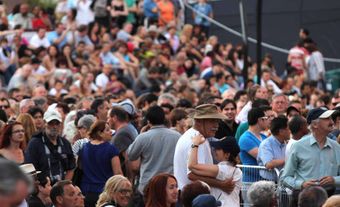Rimouski, Que
Rimouski, Que. City situated on the south shore of the St Lawrence River, 300 kilometres east of Quebec City. The name, meaning 'moose sanctuary,' comes from the Micmac language. It was initially settled at the end of the 17th century by several families; in 1717 the first resident priest, the Parisian Philippe-Pierre Sauvenier de Chopin, arrived. The first stone church was built in 1824. The founding of the parish of St-Germain de Rimouski dates from 1829, and that of the city from 1835. At first known as a manufacturing centre, Rimouski today is a regional metropolis which had a population of 35,000 in 1991.
At first the musical life of Rimouski centred around the teaching establishments. In the seminary, founded in 1864, music studies were promoted from an early date. In 1874, La Société musical de Saint-Cécile introduced instrumental studies. The Schola cantorum started its musical activities in 1911; in 1915 a small orchestra was organized to accompany it. Those closely associated with the musical life of the seminary were Mgr Alphonse Fortin (1899-1971), organist, professor, and composer of the Briève [sic] histoire de l'Alma Mater for chorus and orchestra, on a text by Canon Fortunat Charron, the abbés Antoine Perreault, director of the orchestra and chorus, Raoul Roy, conductor of the children's choir, Charles Morin, conductor of the Harmonie Ste-Cécile, Auguste Lavoie, instructor of piano and organ, as well as Georges Beaulieu, who for many years co-ordinated all artistic activities. In 1976 the present hall, formerly the auditorium of the seminary, was named after him.
The Ursulines taught music from the time they set up their convent school at Rimouski (1906) until their convent became the University of Quebec (1970). The pioneers of music teaching were Mother Marie-de-Jésus, and Mother Marie du Sacré-Coeur, director of the music department from 1914 to 1938. Diplomas were granted initially by the Dominion College, later replaced by the AMQ, and, from 1938, were awarded by the music school of Laval University. By the end of the 1960s, 125 students were studying piano, violin, organ and guitar.
The Order of the Sisters of Notre-Dame du St-Rosaire, founded in Rimouski in 1875 by Élisabeth Turgeon, of Beaumont, Que, at the request of Mgr Jean Langevin, started offering musical instruction ca 1935 under the direction of Sister Victoire Perrault. In 1960 their affiliation with the AMQ for organ and piano instruction was replaced by one with the Extension Department of Laval U; the violin as been taucht according to the Létourneau method. Sister Pauline Carron has taught numerous pianists and organists who have distinguished themselves in the Quebec and Canadian Music Competitions, and who have pursued advanced musical studies in Canada and abroad.
From 1920 many artists have performed in the seminary's auditorium, including Marcel and Yvonne Hubert, Clara Haskil, Edwin Bélanger, Omer Létourneau, Paul-Émile Corbeil, Arthur LeBlanc, Raoul Jobin and André Mathieu. The Société des concerts was affiliated with the Community Concerts; Leonard Warren, celebrated baritone of the Metropolitan Opera, gave its first concert. Between 1941 and 1969 the Société gave 111 recitals, not including those given by the seminary, the JMC (YMC, beginning in 1956), and the Québec.SO
Rimouski is noted for the quality of its organs. The original organ of the cathedral of St-Germain was built in 1875 by Samuel Russell Warren, and restored in 1886 by Ernest Desmarais. In 1921 the firm of Casavant Frères installed a new organ with 62 stops spread over 4 manuals and a set of foot pedals; the organ was inaugurated in a concert of sacred music given by Joseph Bonnet. The present organ, restored by the firm of Guilbault-Thérien in 1979, is particularly suited to the performance of French music. It is installed in the sanctuary and has 63 stops, including bombard, trumpet and clarion, operated by manuals and a set of pedals. Jean-Guy Proulx became the organist in 1969. The organ in the church of St-Pius X was built in 1969 by Casavant. It has 21 stops distributed over 2 manuals and a set of pedals. In 1991, Les Amis de l'orgue de Rimouski (1971-) had already presented 106 concerts on the principal organs of the city.
The Conservatoire de Rimouski began operations in 1973. The University of Quebec has an archival department in which the folklore of the region is featured. The radio station CJBR was inaugurated in 1937; until 1941 its director was Paul-Émile Corbeil. The city also hosts an annual summer jazz festival.
Among those musicians born in Rimouski or in the region, reference should be made to Geneviève Albert-Paradis, Josée April, Danny and Nancy Bélisle, Gaston Brisson, Josée and Martin Caron, Marc D'Anjou, Marcelle Deschênes, Danielle Dubé, Patricia, Carmen, and Suzanne Fournier, André Laplante, Jean Lapointe, Stéphane Lemelin, Richard Raymond, Gilles Rioux, Joseph Rouleau, Chantal Roussel, Germain Saint-Pierre, and Marie-Claude Sirois.

 Share on Facebook
Share on Facebook Share on X
Share on X Share by Email
Share by Email Share on Google Classroom
Share on Google Classroom

